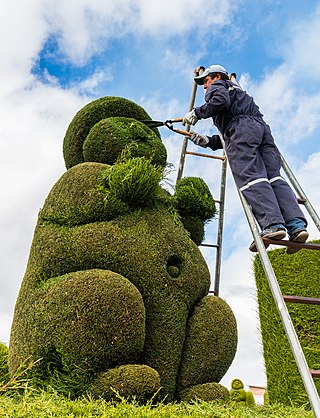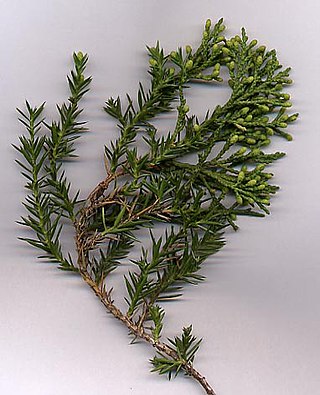Related Research Articles

Gardening is the practice of growing and cultivating plants as part of horticulture. In gardens, ornamental plants are often grown for their flowers, foliage, or overall appearance; useful plants, such as root vegetables, leaf vegetables, fruits, and herbs, are grown for consumption, for use as dyes, or for medicinal or cosmetic use.

Bonsai is the Japanese and East Asian art of growing and training miniature trees in containers, developed from the traditional Chinese art form of penjing . Penjing and bonsai differ in that the former attempts to display "wilder," more naturalistic scenes, often representing landscapes, including elements such as water, rocks, or figurines; on the other hand, bonsai typically focuses on a single tree or a group of trees of the same species, with a higher level of aesthetic refinement. Similar versions of the art exist in other cultures, including the miniature living landscapes of Vietnamese Hòn non bộ. During the Tang dynasty, when penjing was at its height, the art was first introduced in China.

Arboriculture is the cultivation, management, and study of individual trees, shrubs, vines, and other perennial woody plants. The science of arboriculture studies how these plants grow and respond to cultural practices and to their environment. The practice of arboriculture includes cultural techniques such as selection, planting, training, fertilization, pest and pathogen control, pruning, shaping, and removal.

A watering can is a portable container, usually with a handle and a funnel, used to water plants by hand. It has been in use since at least A.D. 79 and has since seen many improvements in design. Apart from watering plants, it has varied uses, as it is a fairly versatile tool.

Juniperus chinensis, the Chinese juniper is a species of plant in the cypress family Cupressaceae, native to China, Myanmar, Japan, Korea and the Russian Far East. Growing 1–20 metres tall, it is a very variable coniferous evergreen tree or shrub.

The 6-acre (2.4 ha) Gardens at Heather Farm are a set of gardens located at Heather Farm Park in Walnut Creek, California, United States. The gardens have a view of Mount Diablo, and are open to the public 7 days a week during daylight hours.

Layering is the process whereby the branch of a tree, or other plant, produces roots and is separated from the original plant, becoming a new, separate plant. Layering is utilized by horticulturists to propagate desirable plants.

Container gardening or pot gardening/farming is the practice of growing plants, including edible plants, exclusively in containers instead of planting them in the ground. A container in gardening is a small, enclosed and usually portable object used for displaying live flowers or plants. It may take the form of a pot, box, tub, basket, tin, barrel or hanging basket.

The University of Michigan Matthaei Botanical Gardens includes botanical gardens, natural areas with trails, and several research-quality habitats and is part of the organization Matthaei Botanical Gardens and Nichols Arboretum. The conservatory is popular year round. The public entrance is at 1800 North Dixboro Road in Ann Arbor, Michigan. The grounds are open every day, but trails are not maintained in the winter. The conservatory, garden store, and lobby are open 7 days a week. The building complex is only closed on three holidays a year.
This is an alphabetical index of articles related to gardening.

Tree shaping uses living trees and other woody plants as the medium to create structures and art. There are a few different methods used by the various artists to shape their trees, which share a common heritage with other artistic horticultural and agricultural practices, such as pleaching, bonsai, espalier, and topiary, and employing some similar techniques. Most artists use grafting to deliberately induce the inosculation of living trunks, branches, and roots, into artistic designs or functional structures.

Chinese Garden is a park in Jurong East, Singapore. Built in 1975 by the JTC Corporation and designed by Prof. Yuen-chen Yu, an architect from Taiwan, the Chinese Garden's concept is based on Chinese gardening art. The main characteristic is the integration of architectural features with the natural environment. The Chinese Garden is modeled along the northern Chinese imperial style of architecture and landscaping. It is located next to Chinese Garden MRT station and connected to the adjacent Japanese Garden by a bridge. Along with Japanese Garden, the two gardens are collectively known as the Jurong Gardens.
A water chiller is a device used to lower the temperature of water. Most chillers use refrigerant in a closed loop system to facilitate heat exchange from water where the refrigerant is then pumped to a location where the waste heat is transferred to the atmosphere. However, there are other methods in performing this action.

Indoor bonsai are bonsai cultivated for the indoor environment. Traditionally, bonsai are temperate climate trees grown outdoors in containers. Tropical and sub-tropical tree species can be cultivated to grow and thrive indoors, with some suited to bonsai aesthetics shaped as traditional outdoor or wild bonsai.
Brian Eric Sampson was an Australian rules footballer who played for Essendon in the Victorian Football League (VFL) and West Perth in the West Australian Football League (WAFL).

Zakir Hussain Rose Garden, is a botanical garden in Chandigarh, India and spread over 30 acres (120,000 m2) of land, with 50,000 rose-bushes of 1600 different species. Named after India's former president, Zakir Husain and created in 1967 under the guidance of Mohinder Singh Randhawa, Chandigarh's first chief commissioner, the garden has the distinction of being Asia's largest. The garden has not only roses, but also trees of medicinal value. Some of the medicinal plants that can be spotted here are bel, bahera, harar, camphor and yellow gulmohar. The rose plants have been planted in carved-out lawns and flower beds.

Bonsai cultivation and care involves the long-term cultivation of small trees in containers, called bonsai in the Japanese tradition of this art form. Similar practices exist in other Japanese art forms and in other cultures, including saikei (Japanese), penjing (Chinese), and hòn non bộ (Vietnamese). Trees are difficult to cultivate in containers, which restrict root growth, nutrition uptake, and resources for transpiration. In addition to the root constraints of containers, bonsai trunks, branches, and foliage are extensively shaped and manipulated to meet aesthetic goals. Specialized tools and techniques are used to protect the health and vigor of the subject tree. Over time, the artistic manipulation of small trees in containers has led to a number of cultivation and care approaches that successfully meet the practical and the artistic requirements of bonsai and similar traditions.

Kokedama is a ball of soil, covered with moss, on which an ornamental plant grows. The idea has its origins in Japan, where it is a combination of the nearaibonsai and kusamono planting styles. Today, Kokedama is very popular in Japanese gardens.
Gardening Naturally is a TV show series hosted by Barbara Damrosch and Eliot Coleman. It was created from 1993 to 1994 and ran until about 2003. It first aired on TLC and later reruns were shown on Discovery Home and Leisure.

Crassula sarcocaulis is a small shrubby succulent plant known by the common name bonsai crassula, due to its bonsai-like appearance. It is a perennial plant native to the eastern half of South Africa, on mountain slopes in rocky terrain.
References
- ↑ Ohio State University Extension, "Gardening Folklore".
- ↑ Tips On How To Make Willow Water Gardening Know How
- ↑ Using Willow Water to root Rose cuttings Texas Rose Rustlers. Pamela Ashworth Puryear. 1986
- ↑ Willow Water for Bonsai Bonsai4me